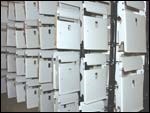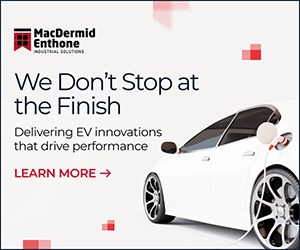The Clear Alternative to Traditional Yellow Hex Films
Chromate conversion coatings on aluminum were implemented initially in 1950 when Allied Research and Rheem Manufacturing used technology based on hexavalent chromium to provide protective chemical films on the metal substrate.
Chromate conversion coatings on aluminum were implemented initially in 1950 when Allied Research and Rheem Manufacturing used technology based on hexavalent chromium to provide protective chemical films on the metal substrate. By the mid-sixties, the terms Iriditing and Alodining based on trade name products, Iridite and Alodine, became synonymous with the formation of a yellow chromate conversion coating on aluminum.1 However, recent European Union Directives such as End-of-Life Vehicles (ELV)2 approved in 2000, Restriction of Hazardous Substances (RoHS)3 and Waste Electrical and Electronic Equipment (WEEE)4 both approved in 2003, place restrictions on traditional hexavalent chromium containing finishes. The new OSHA limitation on hexavalent chromium exposure of 5 mg/m3, has the American metal finishing and electroplating industries deeply concerned over the future of hexavalent bearing chemistries of any kind. The combination of these new governmental policies creates a need for a replacement of hexavalent chromium based finishes with technology that rivals the performance but remains hexchrome-free. This need has created the new name in chemical conversion coating technology, TCP.
The Trivalent Chromium Process, TCP, was developed by United States Navy researchers at their NAVAIR research center in Patuxent River, MD. The patented process5 generates both pre-treatment and post-treatment chem films on wrought and cast grades of aluminum. The conversion coating itself meets or exceeds the requirements of Mil-DTL-81706, Type II for both Class 1A, base metal corrosion protection, and Class 3, minimum electrical resistivity.
“TCP” generates a hex-free chemical conversion coating on aluminum fulfilling the requirements of Mil-C-5541 and compliant with the demands of the European Directives, “ELV,” “RoHS,” and “WEEE.”
General Chemical Description
The Luster-On Products, Inc. version of the TCP, Aluminescent, is a blended powder containing a unique mixture of trivalent chromium salts and metallic fluoride compounds. The working solution is simply prepared by dissolution of the material in water. The product has a limited solubility in water of about 20 g/liter.
The novel technology can be described as a steady-state system, one in which the active complexes do not change state or valence at any time throughout the process; constantly providing a uniform consistent finish. Only a change in the operational parameters can change the physical nature of the conversion coating itself.
TCP contains trivalent chromium and although still considered a hazardous material, the product is far more user friendly and “greener” than its hexavalent counterparts. The U.S. Navy tested the toxicology of the invention following EPA guidelines in the categories of acute oral, acute dermal and acute inhalation sensitivity. The LD50 for both the oral and dermal testing was greater than 2,000 mg/kg and the LC50 for inhalation is greater than 2.25 mg/liter. The dermal classification for the invention is non-sensitizer.6 By comparison, chromic acid has an acute oral LD50 of 52 mg/kg and an acute dermal LD50 of 57 mg/kg. The acute inhalation LC50 is set at 0.217 mg/liter.7
TCP is a drop-in replacement for similar aluminum chromates based on the hexavalent chromium ion and may be used as an effective paint base or independently providing excellent corrosion protection with low electrical resistance. The pre-treatment chemical requirements presently used prior to any hexavalent process suitably meet, in most applications, those of the trivalent process. The invention can be applied by immersion, spray or brush application without the need for current or cooling. Similar to hexavalent technologies, the process is effective on both cast and wrought alloys but usually requires specific pre-treatment chemistries determined by the alloy to be treated.
The process generates a colorless conversion coating on the metal surface with only a slight level of iridescence of bluish or golden yellow hues. Coating weights for the film generally fall in the range of 20–25 mg/sq ft.
Operational Parameters/ Maintenance and Control
Aluminescent, used at 1–2 oz/gal (7–15 g/liter) with a working pH range of 3.5–4.0, best meets the parameters of the Navy’s original invention. The process most satisfactorily operates between room temperature and 120°F. Immersion times of 1–10 minutes are acceptable with 3–5 minutes suggested as optimum.
The pH of the working solution was found to be critical to the success of the film. The pH will slowly rise as the solution forms the conversion coating. Adjustments can be made with a mild (10% v/v) solution of sulfuric acid to lower the pH and a mild (10% wt) solution of potassium hydroxide to raise the pH into acceptable range.
As in most chromating situations, agitation is recommended, but not required, to assist in bringing fresh solution to the interface. Constant movement about the surface of the substrate also aids in keeping the pH equilibrium at its optimum.
The operational parameters of the product are monitored with readily available laboratory equipment. The concentration can be checked titrimetrically by oxidizing the trivalent chromium to the hexavalent state making it readily measured by wet analytical methodology. When instrumentation is available, concentration can also be determined using atomic absorption spectroscopy or color spectrophotometry to measure chromium levels or by ion-selective electrode to measure fluoride concentration. pH should be measured routinely using a standard laboratory pH meter.
The reaction of dissolved aluminum with available fluoride slowly leads to the formation of a white aluminum fluoride precipitate which may cloud the working solution. While it appears not to interfere with the conversion of the aluminum, it can be easily filtered away to keep the working solution clear and the aluminum substrates free from precipitate roughness.
Tanks used to hold the working solution must be resistant to acidic solutions containing fluoride. Polyethylene, polypropylene, PVC and Koroseal lined steel tanks are all acceptable construction materials. Air sparges, heaters, or spray systems when desired, should also be of suitable construction materials. Appliances, used to hold aluminum to be processed, constructed of dissimilar metals may cause galvanic reactions which interfere with film formation. Pumps or filtration units should have acid and fluoride resistant wetted materials.
Performance Results
Various aluminum alloys have been processed and then tested to ensure universality of the invention. The alloys tested by the Navy include 2024, 2219, 5083, 6061, and 7075, with in-house testing focused on 2024, 3105, 6061, 7075 and A380. All in-house testing was done using a 1.5 oz/gal solution at room temperature (65–85°F) within a pH range of 3.5–4.0. Immersion times were typically held at three minutes and five minutes for castings. The NAVAIR testing centered on an equivalent of a 1.0 oz/gal solution at room temperature with a pH of 3.7–3.8 and typically two minute immersion times.8 In both cases, pre-treatment deoxidizers were determined by the test alloy.
The function of the coating as a pre-treatment chem film was examined in-house by applying paint and then testing paint adhesion according to ASTM D-1654 after 3,000 hours of exposure to salt spray per ASTM B-117. After exposure, the test panels achieved a rating of nine for minimal creepage from the scribe and a 10 rating for no failure in unscribed areas. The Navy compared the TCP process with hexavalent counterparts and determined that the trivalent process was capable of achieving similar results under conditions of cyclic testing, long term weather exposures, scribed salt spray studies, filliform testing and various adhesion tests.8
| Table 1—Corrosion Protection Afforded by the TCP Process Determined via Salt Spray Exposure per ASTM B-117 | ||
|
Alloy Tested
|
Hours in NAVAIR Test Cab
|
Hours in Company's Test Cabinet
|
|
2024
|
>336*
|
336
|
|
2219
|
<336
|
Not tested
|
|
3105
|
Not Tested
|
>504*
|
|
5083
|
>336*
|
Not tested
|
|
6061
|
Not tested
|
>504*
|
|
7075
|
>336*
|
>504*
|
| * End of Test Period | ||
Bare metal corrosion studies were performed in conjunction with Mil-DTL-81706 and ASTM B-117. The Navy tested alloys 2024, 2219, 5083 and 7075 with all but the 2219 passing 336 hours of exposure without first sign of corrosion. The 2219 alloy showed initial signs of corrosion but not enough damage to cause failure under the stipulations of the military specification. Luster-On processed and tested alloys 2024, 3105, 6061, 7075 and A380 with all but the A380 surpassing 336 hours of exposure without first sign of corrosion. The A380 castings showed initial signs of corrosion between 240-288 hours of exposure. A compilation of corrosion resistance results are found in Table 1 on the previous page.
The NAVAIR group tested the electrical resistance of the coating in conjunction with Mil-DTL-81706, Type 3. The films were checked as required before and after exposure to a salt fog for 168 hours. Prior to salt spray exposure, the average contact resistance of 5 test panels averaged 1.57 milliohms/in2 (0.24 milliohms/cm2). After 168 hours of exposure, the contact resistance was determined to average 3.19 milliohms/in2 (0.49 milliohms/cm2) on five test panels.8
The invention shows promise as a hex chrome replacement in the fields of zinc and zinc alloy passivation, a sealant for anodized aluminum and zinc and iron phosphate conversion coatings, generating protective coatings on metallic substrates and pre-treatment chem films for magnesium alloys.
The TCP process compares favorably with its hexavalent counterparts in providing a conversion coating on aluminum which meets or exceeds the requirements of Mil-C-5541, Type 1A and Type 3. The product is a drop-in replacement for its hexavalent counterparts. The conversion coating which simultaneously fulfills the corrosion and electrical resistance requirements can be generated using the same operating parameters; something that most hexavalent systems cannot do. The chem film is an excellent paint base prior to e-coat, powder coat or traditional primer and paint systems. The finished product is compliant with all European Directives by being completely free of hexavalent chromium, cadmium, lead or mercury. All of the present needs for aluminum chem film technology have been met and the new term in the industry is TCP.
Related Content
In-House Blackening of Ferrous and Non-Ferrous Metals
Process satisfies customers’ shipping requirements while meeting stricter water regulations in times of drought.
Read MoreNASF/AESF Foundation Research Project #122: Electrochemical Approaches to Treatment of PFAS in Plating Wastewater - 7th Quarterly Report
The NASF-AESF Foundation Research Board has selected a project on addressing the problem of PFAS and related chemicals in plating wastewater streams, studying PFAS destruction via electrooxidation and electrocoagulation. Our last report described the results from experiments of EO with a Magnéli phase Ti4O7 anode on the degradation of eight perfluoroalkyl acids (PFAAs). In this seven quarter report, we describe work to further explore how the degradation of different PFAAs are related to their molecular structures.
Read MoreNew Jersey DEP Proposes Comprehensive Environment Justice Regulation
New Jersey proposed environmental justice regulations take unprecedented action to require consideration of impacts on overburdened communities in the permitting process. This regulatory process could serve as a model for other states.
Read MoreElectraMet Names New CEO
ElectraMet names Keith Jacobs as its new chief executive officer.
Read MoreRead Next
Powder Coating 4.0: Smarter, Faster, More Efficient and Connected
New tools reduce cost and waste, lower manufacturing footprint of powder coating operations.
Read MoreEpisode 42: An Interview with Robin Deal, Hubbard-Hall
Hubbard-Hall wastewater treatment specialist Robin Deal discusses the latest trends in wastewater management.
Read MoreThe 2024 Ford Mustang: All the Colors Available
Although Chevrolet has announced the end of the Camaro and Dodge is offering “Last Call” editions of the Charger and Challenger, the Ford Mustang is launching to its seventh generation.
Read More































